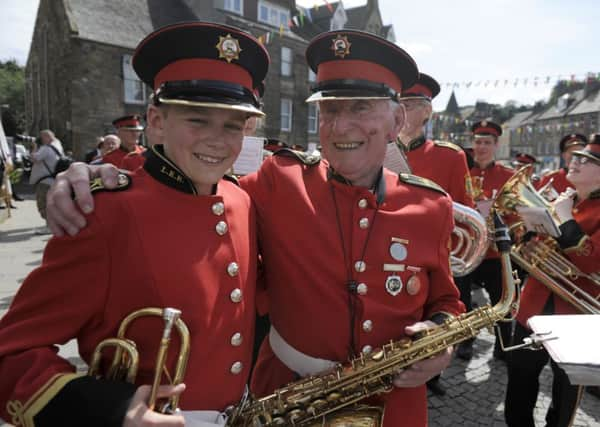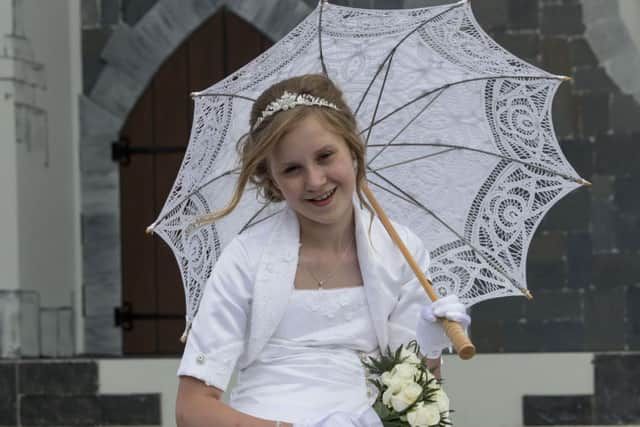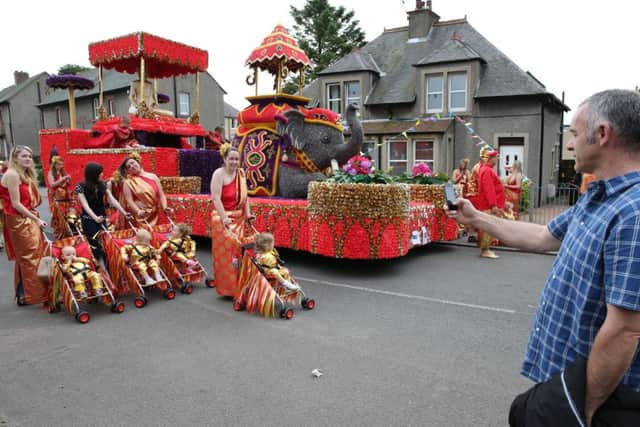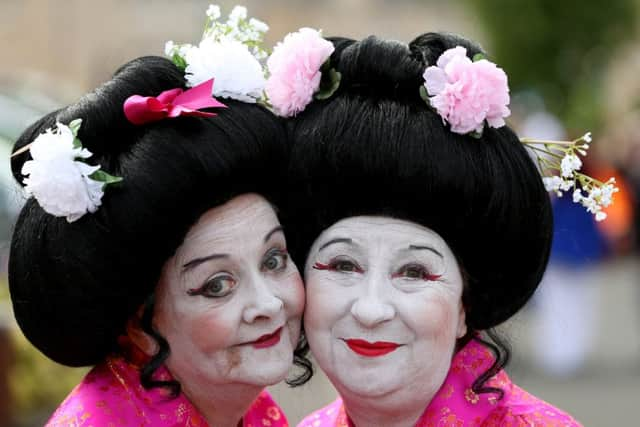Scotland’s community galas: Queens for the day


“Oh, it’s emotional,” says one old man afterwards, dabbing his eyes with a paper hankie. “I think of my wife that I’ve lost and the friends that I’ve lost.”
This is the Marches, the annual festival which has taken place in the town for hundreds of years. The people of Linlithgow, who are pleased to call themselves Black Bitches after an ancient legend involving a loyal hound, have a great passion for the Marches – named for the practice of riding out to inspect the March Stones which marked the boundary of the town land. It is a thronging celebration of kinship and belonging, home and heart, a grand, noisy occasion fuelled by long draughts of pride and a few whisky chasers, and at the very start of it is this moment of reflection when locals think of those dear to them, now gone, who loved and shared days like this. The Lord may be their shepherd, but what Linlithgow folk celebrate is their joy at being part of a flock.
Advertisement
Hide AdEvery summer, from Ayrshire to Fife, you’ll find these fairs and gala days. They don’t get much attention beyond a few photos in the local papers but they mean a great deal to tens of thousands of people. There are around 70 such events in Lanarkshire and the Lothians alone. The heartland is in post-industrial working class communities; pit villages which no longer have a pit, mill towns without mills – these are the places where fairs and galas flourish, expressions of identity that have come to replace the togetherness once offered by shared employment.


Fairs and galas are paid little mind by media and academia
Yet, in comparison with the Common Ridings or the Highland Games, fairs and galas are paid little mind by both media and academia. They are regarded, somehow, as trivial. Alan McLaren, a stalwart of Loanhead Children’s Gala Day and author of a history of Midlothian’s local festivals, believes there is a widespread misunderstanding that events including his are recent inventions when, in fact, their roots go much deeper.
“There’s a lot of ignorance,” he says. “Galashiels, Kelso, Jedburgh, Coldstream, Duns – all are relatively modern inventions. But if an event involves adults riding about on horses then that’s seen as culturally more important than those where children play the principal parts. That’s a mistaken view. You’re basically writing off the tradition in a large part of lowland Scotland.”
A central Scotland summer can be dazzling


Quite right. A central Scotland summer can be a dazzling, almost trippy spectacle of pomp and pageantry. Bo’ness, for example, is home to what claims to be the biggest children’s fair in Europe. Beginning in the 18th century as a drunken celebration of the end of the indentured labour among coal miners, it has developed into a colourful ceremony in which one local schoolgirl is chosen to be Queen (this year it’s 12-year-old Louise Wilson) while other school children become the royal retinue – page boys, heralds, fairies, flowergirls and the like. Most extraordinary are the frontages, known as arches, which many Bo’nessian families build in front of their homes.
Palaces, medieval fortresses, magical grottoes – anything goes. “This has just gone up today,” says Claire McComb, pointing across the street at the 30 ft tall wooden castle standing in her garden. “The crane is just away.”
The streets echo with the sound of hammering and sawing
Her 11-year-old son Jamie is Champion, the main boy part, at this year’s Bo’ness Fair. Parents of a child elected to one of the principal roles enjoy a few moments of hyperventilating pleasure on receiving the phone call from the school, but then the realisation sets in that only a few months hence they will have to build an arch and it will have to be fabulous, costing anything from £2,000 to £10,000. Families fundraise to pay for this, but there is also a massive investment of time and energy. In June, the streets echo with the sound of hammering and sawing, while smoke machines and spotlights are fetched down from lofts. It is the Las Vegas strip made manifest on the Firth of Forth. And each year the arches seem to get bigger. It is as if the gargantuan industrial architecture of the nearby Grangemouth oil refinery, with its belching cooling towers and dragonish gas flares, had influenced both the scale and aesthetic swagger.


Advertisement
Hide AdThe great night for arches is Fair E’en, the evening before the big day, when Bo’nessians saunter through the streets, from showy villa to roughcast council terrace, admiring what has been made – and all that work for just a couple of days. “Yeah,” laughs Claire McComb at the thought of this, “I’m threatening to keep ours up till Christmas.”
The Bo’ness Fair is modelled, in part, on Lanark’s Lanimer Day, thought to be the first fair in Scotland at which a local child is crowned Queen. That goes back to 1893, though Lanimers itself dates from 1140 when the town was made a royal burgh. It takes place over the course of a week in June, the main day being the Thursday. It is a splendid scene, the whole town packed on to the steep High Street for the grand parade, bunting bright against the blue sky. “This,” as one local woman puts it, “is a Scottish Mardi Gras.”
In Lanark, rather than arches, the big thing is floats.
They are known as Lanimer lorries
Advertisement
Hide AdYou can’t call them floats, though, without attracting hoots of derision. They are known as Lanimer lorries. There are 24 lorries in the procession this year, each competing for the coveted grand prize, the Silver Bell Trophy. There are, in addition, awards for different categories of lorry, depending on its size and whether it is powered by an engine or shoved-and-shoogled along by hand. There are just two in the Motorised Large category this year: both gigantic; one inspired by the culture of Thailand, the other by Japan; and each decorated with tens of thousands of handmade paper flowers. These have been constructed by rival teams of lorry builders – the Kranal Club and Kilninie Club – who, between them, have dominated the competition for decades. This is the Old Firm, the El Clásico, of Lanimer Day.
For two reasons, there is even more of an edge this year. One, A Glimpse Of Japan is the last ever Lanimer lorry of Beth Brown, 66-year-old head of the Kranal Club. Two, there has been quite a stooshie, with the Kilninie Club accused of cheating by incorporating into their lorry a large model elephant which had been made in Jersey for that island’s annual carnival, The Battle Of The Flowers. Kranal members are certainly unhappy about this – “Their Buddha’s smaller than ours and their elephant’s bought in,” harrumphs one.
But Loraine Swan, the 64-year-old retired teacher who heads the Kilninie, says there’s nothing in the rules to say that everything has to be made from scratch. The accusations have been hurtful for the Kilninie, she says, and don’t take account of all the hard work that has gone into making their lorry, Treasures Of Thailand. “There’s a chap called Keith who’s been in our group for years. He’s 87. He made the Buddha in his garage.”
Unquestionably, the Lanimer lorries are remarkable. To consider them alongside the Bo’ness arches is to feel that here is not just a bit of fun, but actually a kind of folk art. It feels inadequate to simply applaud as they pass along Lanark’s narrow winding streets. You want, instead, to rush out and award the Turner Prize.
Mississippi paddle-steamers, pirate ships, giant golfers, a zombie apocalypse
Mississippi paddle-steamers, pirate ships, giant golfers, a zombie apocalypse – each a hand-knitted masterpiece in its own way. The Kranal and Kilninie lorries, though, are something else. Both have been built up around old tractors to the approximate size of a long-distance truck, and together are a far-eastern phantasmagoria of pagodas, peacocks and golden boats as well as Lanarkians dressed as samurai warriors and Thai royalty. The Kranal lorry, one must add, blasts out Japanese Boy by Aneka as it rolls along at a stately five miles per hour, prompting one young man with Big Sexy printed across the back of his Chelsea top to raise his Buckfast bottle in a toast of heartfelt if glaikit admiration.
Advertisement
Hide Ad“We’ve made a few masterpieces. I know before it leaves the shed whether it’s a contender,” Beth Brown says. She is dressed as a geisha, a look she carries off with gallus aplomb. A Glimpse Of Japan is her 53rd lorry. Valhalla, Caesar’s Palace, the Moulin Rouge – she and her crew have made them all. They are built in the barn of a sympathetic local farmer by a small team who only occasionally feel the urge to put their hands around Brown’s throat. Planning starts immediately following Lanimer Day and building begins over the winter. Each of the tens of thousands of paper flowers must be cut and shaped by hand, the most crucial stage in the process known as fluffing. “Ah’ve been fluffin’ since October,” groans one Lanarkian, Wee Karen, the numbness in her arms soothed somewhat by winning the Non-Motorised Large category.
Beth Brown, perhaps inevitably, is victorious in this valedictory year. The Silver Bell is, for the last time, hers. She leaps up when the announcement is made. “I always take off,” she says later. “I remember the first year that I won, I lifted my hat and threw it in the air. This auld woman in the crowd caught it, and she went, ‘How much have ye won?’ Well, it was fiver. So she says, ‘Pit yer bloody hat back on yer heid, hen!’ She didn’t realise how much this means to me. Oh, we’re going out on a high.”
Advertisement
Hide AdPeople in Lanark, in Bo’ness, will tell you the local fair is the best day of the year. We hear so much these days about fractured, purposeless towns. Well, the fairs offer a once-a-year jolt of civic unity. They are, therefore, not just pleasant but relevant, even vital.
A stake in the community
As Alan McLaren sees it, the lack of social cohesion which contributed to the English city riots of 2011, and which is manifest in the drunken violence and lairiness apparent in many Scottish towns at weekends, can be mitigated, in part, by galas and fairs. “If people feel that they have a stake in their community then they’re not going to burn it down,” he says. “In Loanhead, we certainly find – and the local community police officers tell us – that there is an actual benefit in terms of reducing crime, youth disorder and anti-social behaviour. That’s because of the strong community spirit and identity.”
In Eyemouth, many would agree that the annual Herring Queen festival is the backbone of the town. Like too many Scottish fishing ports, Eyemouth has seen a steep decline in the industry around which it first grew. There were once so many boats in the harbour, it is said, that you could walk right across from deck to deck without getting your feet wet. Now, as a result of various factors – EU policies; decline in fish stocks; young men seeking more lucrative and steady work in the oil industry – there are few fishermen left. “It’s important that folk know that places like Eyemouth are living on a pacemaker,” says Johnny Johnston, a retired skipper and former harbour master. “The harbour is the heart of the community, and if that heart stops beating the toon’s dead.”
Against this backdrop, one could detect a certain grim irony in persisting with a festival intended to bring luck and prosperity to those at sea. They don’t even fish for herring out of Eyemouth these days, it’s mainly prawns. Yet this 26 July will be the 70th anniversary of the festival; the first Herring Queen was crowned in 1939 but there followed a hiatus during the Second World War. The girl chosen is always 14 or 15 years old. Wearing a cloak decorated with fishing net, she sails the short distance down the coast from St Abbs, coming ashore at Eyemouth and being crowned by the queen from the previous year. The idea is that she has been plucked from the seaweed, a silver darling in the form of a girl.
Talk to a Herring Queen from each decade since the 1940’s
Remarkably, some 64 of the 69 former queens are still living, and many still live locally, as, of course, does this year’s queen-to-be, 15-year-old Ailsa Landels. You can go to the town and talk to a Herring Queen from each decade since the 1940s. You can ask them what they remember and they’ll tell you about the noise of the crowds, the tears of pride, the chill of the haar against their skin and the way Eyemouth emerged from this sea-mist like Brigadoon.
The first queen, Mary Craig, died in 2010 at the age of 87. It meant a lot to her that she had been Herring Queen. Her daughter Muriel discovered her pink silk dress while clearing the house and has made a long-term loan of it to the local museum; it is a delicate relic which shows its years, and there’s something moving in the thought of the lass who wore this on 22 July, 1939, on the cusp of womanhood, the cusp of war. It must have been an act of tremendous optimism and faith to inaugurate the festival when everyone knew that the barbed wire and bombing raids were just up ahead.
Advertisement
Hide AdAnne Collin, now 82, was the first Herring Queen after the war. She was called Anne Rosie back then, in 1946, but she married James Collin the following year, at 16. She and her husband had been born in the same room in the same house, hard by the harbour. When his family moved out, hers moved in. They grew up together. Their marriage, which lasted almost 60 years until his passing, was preordained, she says laughing. He saw her being crowned, and they saw their daughter, Margaret, crowned in turn in 1969. Although she was a shy teenager rather stunned by the noise and excitement of the ceremony following the dreary years of the war, Anne was conscious that she was emblematic of Eyemouth’s desire to get back to normal and fill their nets with herring.
She herself needs no lessons in abundance having had four children, ten grandchildren and 19 great-grandchildren, a veritable shoal. The 20th is due shortly after this year’s ceremony. Her time as queen shines as bright in memory as the silver brooch she wore for the first time on the day and still owns. “It lingers on,” she says, “in your mind forever.”
Advertisement
Hide AdBack in Linlithgow, at the Marches, the ceremony is reaching its climax, the procession circling the old town well three times. All day it has been fiercely sunny, but now the rain begins, falling in great sultry drops on women in summer frocks, worthies in ermine, and red-faced men in deerstalkers and tweed. It falls on the trilby of Peter Henderson, a 69-year-old known as “Zoom”, in his mobility scooter decorated with a giant cardboard cut-out of his hero Elvis Presley, and it falls on the peaked cap of Eddie McKenna, 83, a founder member of the Linlithgow Reed Band back in 1956 and playing saxophone still. He is playing Auld Lang Syne as the Linlithgow folk join hands and sing with rain on their faces.
Discussions of nationhood
This is a historic summer in Scotland, with discussions of nationhood filling every newspaper and news channel. Yet to travel around the country’s towns and villages on these fair days, each high street tricked out in Saltires and Union Flags, each town band playing Scots Wha Hae and God Save The Queen, is to realise that what matters to people as much and perhaps even more than national identity is local pride. Yes, we are Scots, but we are, too, Bo’nessians, Lanarkians and the rest. We are the streets on which we grew up, every gable, cobble and pebbledashed semi.
That is why there is such happiness and a sense of belonging to be found by involving oneself in fairs and galas, whether as a crowned head or simply making sandwiches for the picnic. Blessed, then, are the piece-makers; blessed are the riders of marches and builders of arches; blessed are the Herring Queens, the Black Bitches and Beth Brown, the grand lady of the Lanimer lorries – for they shall inherit that small Scottish corner of the earth which they call home and which, for them, is heaven. n
Twitter: @PeterAlanRoss
SEE ALSO: